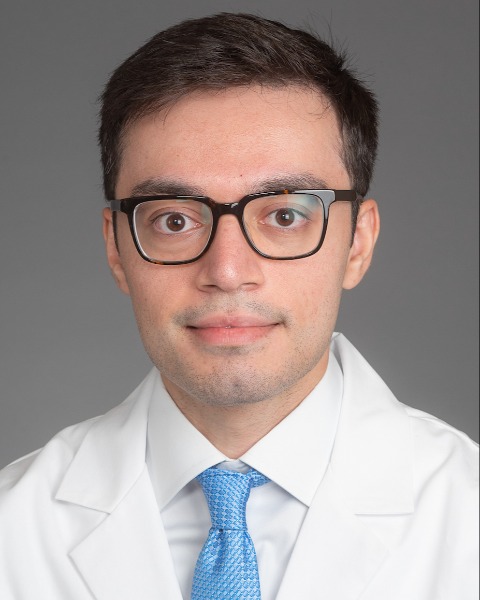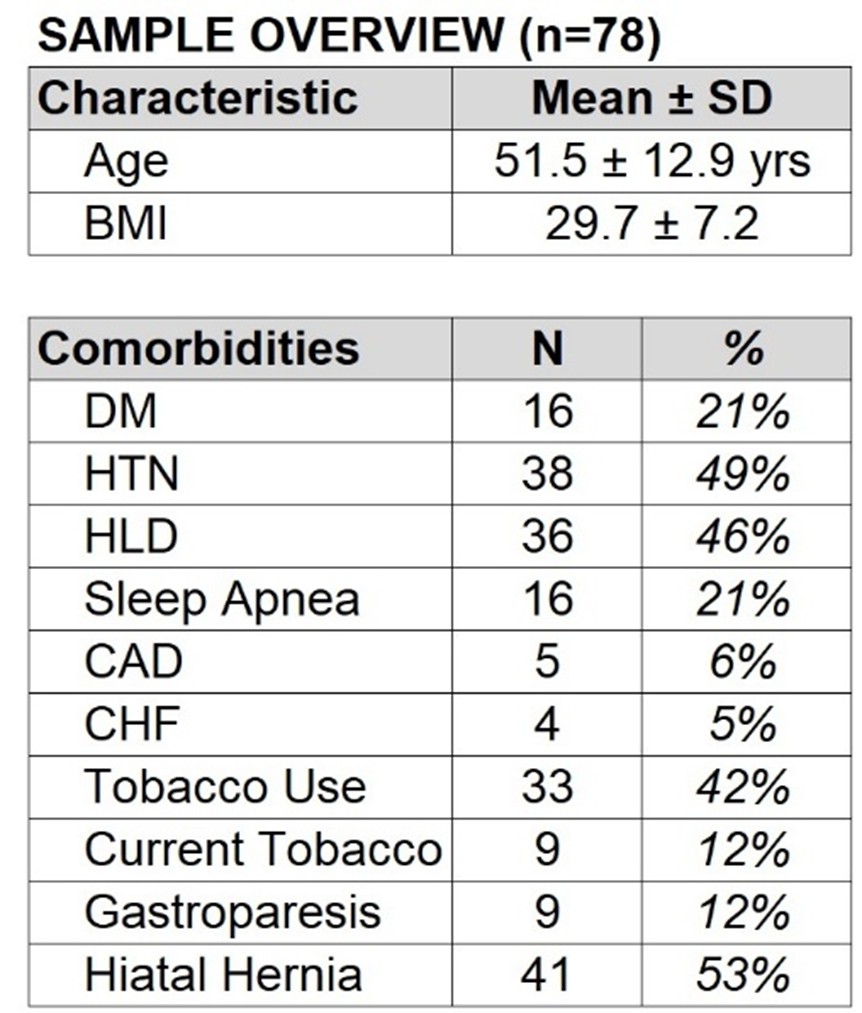Monday Poster Session
Category: Esophagus
P2777 - Efficacy of the Stretta Procedure at Treating Gastroesophageal Reflux Disease: A Single Center Study
Monday, October 27, 2025
10:30 AM - 4:00 PM PDT
Location: Exhibit Hall

Zohayr A. Khan, BS
Wake Forest University School of Medicine
Winston-Salem, NC
Presenting Author(s)
Zohayr A. Khan, BS1, Victoria A. Margolis, MD2, Steven B. Clayton, MD1
1Wake Forest University School of Medicine, Winston-Salem, NC; 2Atrium Health Wake Forest Baptist, Winston-Salem, NC
Introduction: The treatment options for gastroesophageal reflux disease (GERD) include medications, surgery, and newer endoscopic treatments such as the Stretta procedure (Restech; Houston, TX), which administers radiofrequency ablation to augment the lower esophageal sphincter (LES) function. This study aims to retrospectively evaluate the Stretta procedure’s effectiveness at treating GERD at a large, academic medical center.
Methods: A retrospective chart review was conducted for 78 patients that underwent the Stretta procedure at a single academic medical center from January 2019 to April 2024. For each patient, we abstracted data from their past medical and surgical history, medications, and any quality-of-life surveys that they completed pre-Stretta. Additionally, we recorded patient-reported symptoms and results of diagnostic testing completed before and after the Stretta procedure.
Results: The mean age of the cohort was 51.5 ± 12.9 years. 9/78 (11.5%) of patients had gastroparesis, 41/78 (52.6%) had a hiatal hernia generally 2cm or less, and 29/78 (37.2%) had BMI ≥ 30. Of the 47/78 (60.3%) patients who were administered the GERD-Q survey prior to Stretta, mean score was 10.8 ± 3.1 (out of 18), with 40/47 (85.1%) scoring ≥ 8. We identified 13/78 (16.7%) patients for whom we could compare the results of pre- and post-Stretta esophageal acid exposure testing (pH-impedance and/or Bravo). For testing completed on acid-suppressive medications (n=9), a paired t-test showed a significant increase in esophageal acid exposure time (Mean: +5.5%, p=0.030) after Stretta. For testing completed off medications (n=4), a paired t-test showed a significant decrease in acid exposure time (Mean: -3.2%, p=0.027) after Stretta. Changes in DeMeester score were insignificant. Of the 77/78 (98.7%) patients taking proton pump inhibitors (PPIs) after Stretta, 14/77 (18.2%) completely weaned off. Finally, 61/78 (78.2%) patients reported some level of GERD symptom improvement after Stretta.
Discussion: The effect of the Stretta procedure on acid exposure time varied by whether testing was done on vs. off acid-suppressive medications. Patients’ ability to wean off medications post-Stretta (especially PPIs) was limited. Nevertheless, most patients reported some symptom improvement after the procedure, suggesting therapeutic value from the procedure. These results should be interpreted within the constraints of a small sample size and variability in the length of time elapsed between pre- and post-Stretta testing.

Figure: Table 1: Patient Characteristics

Figure: Figure 1: Effect of Stretta on Esophageal Acid Exposure and DeMeester Score
Disclosures:
Zohayr Khan indicated no relevant financial relationships.
Victoria Margolis indicated no relevant financial relationships.
Steven Clayton indicated no relevant financial relationships.
Zohayr A. Khan, BS1, Victoria A. Margolis, MD2, Steven B. Clayton, MD1. P2777 - Efficacy of the Stretta Procedure at Treating Gastroesophageal Reflux Disease: A Single Center Study, ACG 2025 Annual Scientific Meeting Abstracts. Phoenix, AZ: American College of Gastroenterology.
1Wake Forest University School of Medicine, Winston-Salem, NC; 2Atrium Health Wake Forest Baptist, Winston-Salem, NC
Introduction: The treatment options for gastroesophageal reflux disease (GERD) include medications, surgery, and newer endoscopic treatments such as the Stretta procedure (Restech; Houston, TX), which administers radiofrequency ablation to augment the lower esophageal sphincter (LES) function. This study aims to retrospectively evaluate the Stretta procedure’s effectiveness at treating GERD at a large, academic medical center.
Methods: A retrospective chart review was conducted for 78 patients that underwent the Stretta procedure at a single academic medical center from January 2019 to April 2024. For each patient, we abstracted data from their past medical and surgical history, medications, and any quality-of-life surveys that they completed pre-Stretta. Additionally, we recorded patient-reported symptoms and results of diagnostic testing completed before and after the Stretta procedure.
Results: The mean age of the cohort was 51.5 ± 12.9 years. 9/78 (11.5%) of patients had gastroparesis, 41/78 (52.6%) had a hiatal hernia generally 2cm or less, and 29/78 (37.2%) had BMI ≥ 30. Of the 47/78 (60.3%) patients who were administered the GERD-Q survey prior to Stretta, mean score was 10.8 ± 3.1 (out of 18), with 40/47 (85.1%) scoring ≥ 8. We identified 13/78 (16.7%) patients for whom we could compare the results of pre- and post-Stretta esophageal acid exposure testing (pH-impedance and/or Bravo). For testing completed on acid-suppressive medications (n=9), a paired t-test showed a significant increase in esophageal acid exposure time (Mean: +5.5%, p=0.030) after Stretta. For testing completed off medications (n=4), a paired t-test showed a significant decrease in acid exposure time (Mean: -3.2%, p=0.027) after Stretta. Changes in DeMeester score were insignificant. Of the 77/78 (98.7%) patients taking proton pump inhibitors (PPIs) after Stretta, 14/77 (18.2%) completely weaned off. Finally, 61/78 (78.2%) patients reported some level of GERD symptom improvement after Stretta.
Discussion: The effect of the Stretta procedure on acid exposure time varied by whether testing was done on vs. off acid-suppressive medications. Patients’ ability to wean off medications post-Stretta (especially PPIs) was limited. Nevertheless, most patients reported some symptom improvement after the procedure, suggesting therapeutic value from the procedure. These results should be interpreted within the constraints of a small sample size and variability in the length of time elapsed between pre- and post-Stretta testing.

Figure: Table 1: Patient Characteristics

Figure: Figure 1: Effect of Stretta on Esophageal Acid Exposure and DeMeester Score
Disclosures:
Zohayr Khan indicated no relevant financial relationships.
Victoria Margolis indicated no relevant financial relationships.
Steven Clayton indicated no relevant financial relationships.
Zohayr A. Khan, BS1, Victoria A. Margolis, MD2, Steven B. Clayton, MD1. P2777 - Efficacy of the Stretta Procedure at Treating Gastroesophageal Reflux Disease: A Single Center Study, ACG 2025 Annual Scientific Meeting Abstracts. Phoenix, AZ: American College of Gastroenterology.
